Kreed the Conservation Dog Is a Poacher’s Worst Nightmare
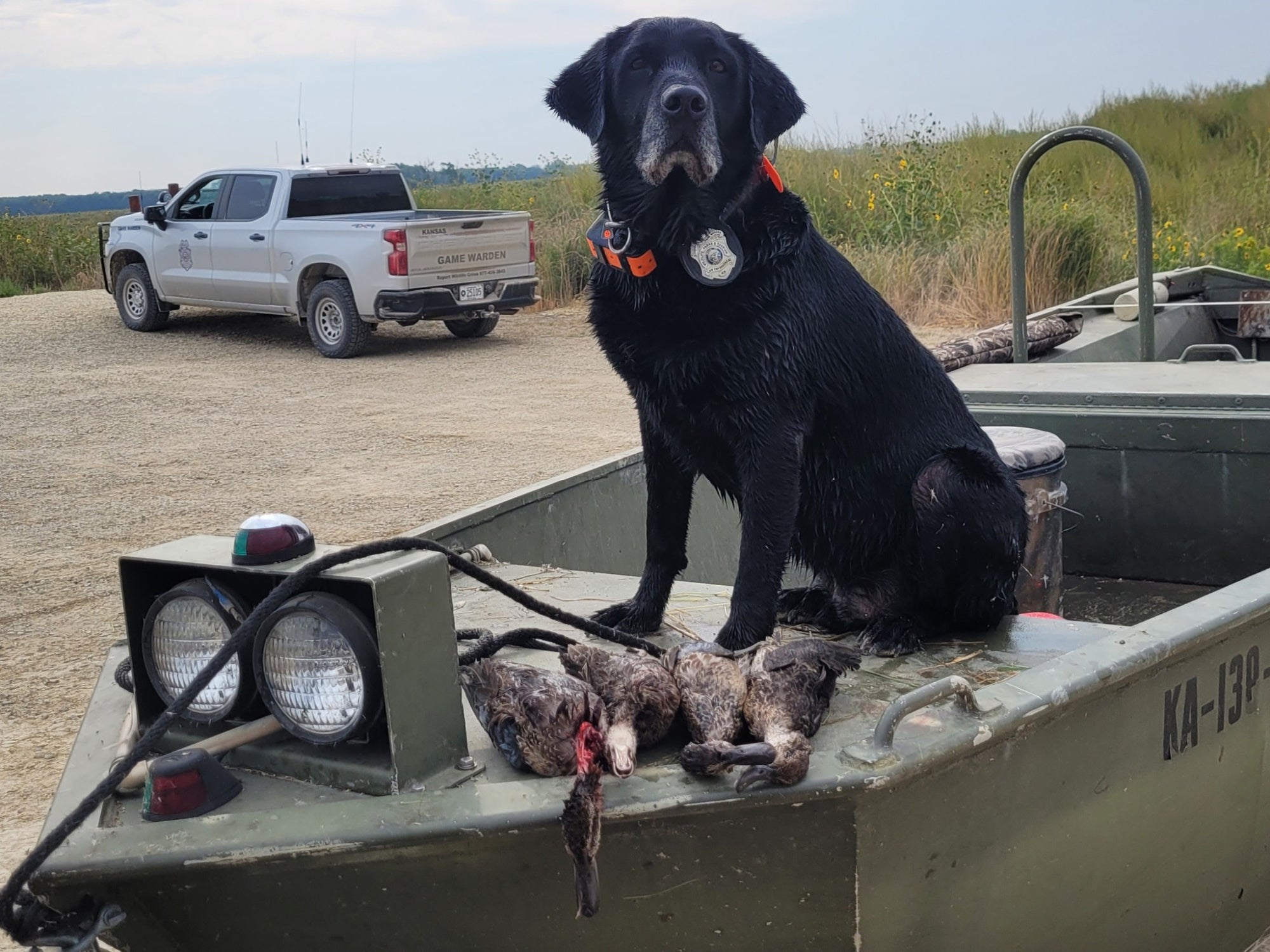
On a cold night in Graham County, Kansas in December 2022, game warden Jacob Brooke watched a small light dart through a field of tall grass in the dark. He waited for the light to stop and stay in one place. It emanated from a GPS collar strapped around the neck of Brooke’s K9 sidekick, a 7-year-old black Labrador retriever named Kreed. It’s a good thing when Kreed stops moving. That usually means he found something important—something that could change the course of a wildlife crime investigation.
Brooke, 42, and Kreed were responding to a call from a landowner who had witnessed a truck exhibiting suspicious behavior on a road that cut through his property. When the landowner heard a gunshot ring out from near the truck, he hopped in his own truck and followed the offending vehicle, snapping photos of the license plates. Eventually, the truck stopped and the passenger side door opened. A guy got out and swore up and down that he had only shot a coyote. Then he climbed back in the truck and sped off, and the landowner called Brooke.
Kreed found the .243 casing in the road within minutes of arriving at the scene. Even though coyotes are considered a non-game species in Kansas, the shooter had broken the law anyway by shooting onto private property without permission. But Brooke had a sneaking suspicion that the animal the suspect had shot wasn’t actually a coyote. He just needed Kreed to figure out what species—and where—the animal was.
This is Kreed’s job as a conservation dog, and he’s very good at it. Brooke has put him through a rigorous training program to detect and track the scent of humans, deer, turkeys, pheasants, and waterfowl. The duo is one of 10 units in the Kansas Department of Wildlife, Parks, and Tourism’s K9 program, which has assisted in countless criminal investigations since its founding in 2002. The dogs are trained to sniff out everything from pronghorn to paddlefish roe, and when they find something of interest, they sit and wait patiently for their reward.
In Kreed’s case, that reward is a quick game of fetch with his rubber Kong. He’d already been rewarded that night for finding the bullet casing on the road. It wouldn’t be long before he was rewarded again for finding something else.
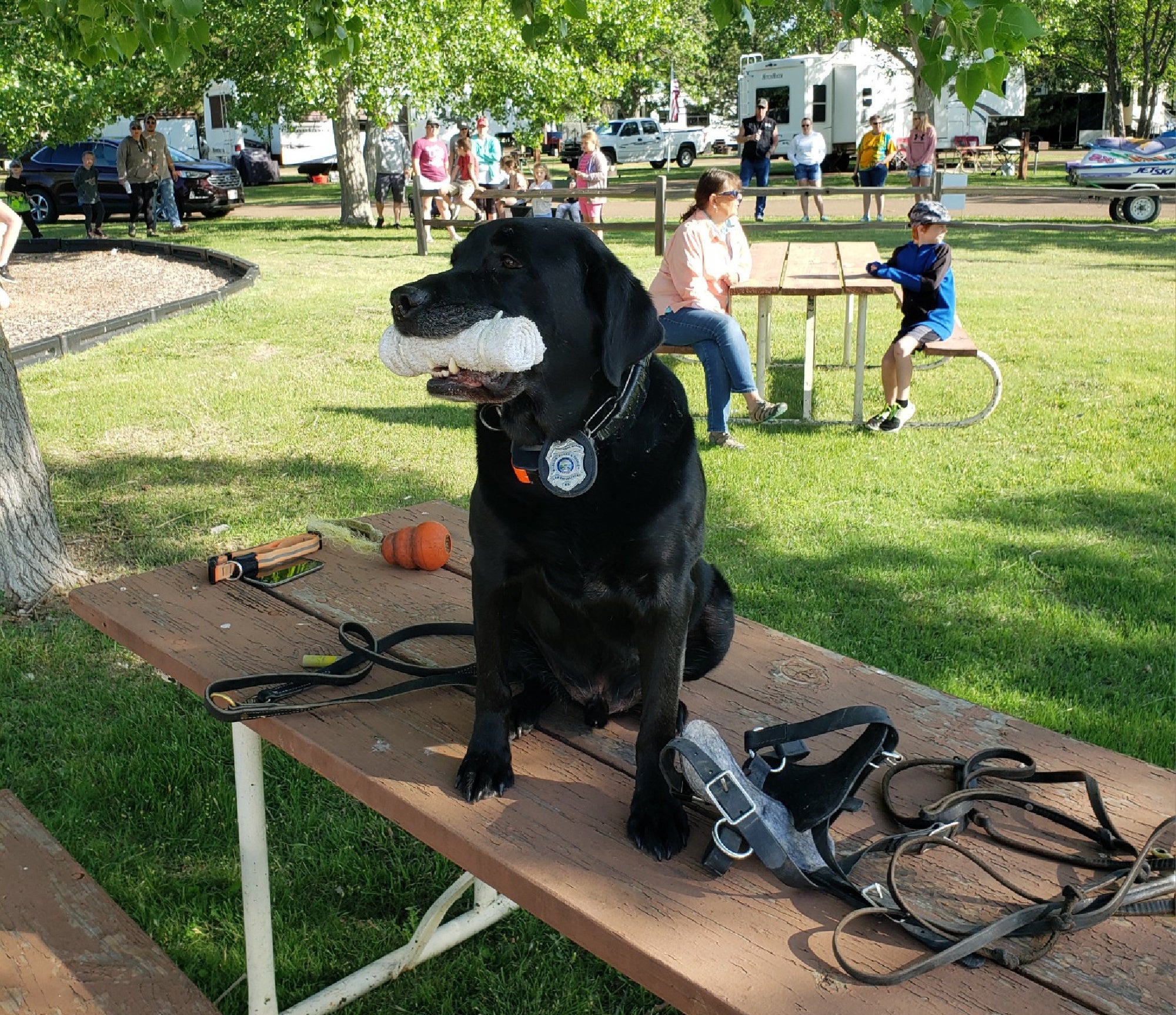
A Man and His Dog
Brooke met Kreed for the first time in 2017. Prior to that year, KDWPT had gotten their conservation dogs from pounds, shelters, and families who were giving up their pets. But this time, Brooke had $1,000 of agency money to spend on a new dog of his choosing, he tells Outdoor Life. After ample research, he landed on Silver Lake Retrievers in Forman, North Dakota. The breeder drove a wiggly 3-month-old puppy over nine hours to Salina, Kansas.
“I thought, ‘Man this dog is gonna be pretty cool. He’s got what it takes,’” Brooke says. “He was jumping in the grass, fetching, sniffing, he was fearless. So we purchased him right there on the spot. From then on, he’s been beside me pretty much 365 days a year.”
Conservation dogs live with their handlers full-time, Brooke explains, so he moved Kreed in immediately. Brooke would have to wait until Kreed was at least a year old to start formally training him. K9 trainers wait this long to ensure their dogs are old enough to comprehend and retain the training. In the meantime, he focused on socializing the puppy, teaching him basic obedience, and exposing him to as much of the world around him as possible.
When Kreed was just 5 months old, he got away from Brooke at a KDWPT satellite office and ran into the road. A truck hauling a camper plowed into the puppy, running over his legs.
“He’s just running, being a dog, and here comes the truck pulling the camper, and it hits him broadside,” Brooke recalls. “The rear tire on the driver’s side hit Kreed in the rear part of his body. I holler to the office manager to call the vet and I run outside and scoop him off the ground. He’s trying to bite my face because he’s in so much pain, and he’s bleeding.”
Once Brooke got Kreed to the vet, they reassured him that his dog was very much alive and not dealing with any major internal organ damage. He did, however, break his legs and all the ribs on his left side. The vet instructed Brooke to drive Kreed to the veterinary hospital at Kansas State University, over two and a half hours away in Manhattan.
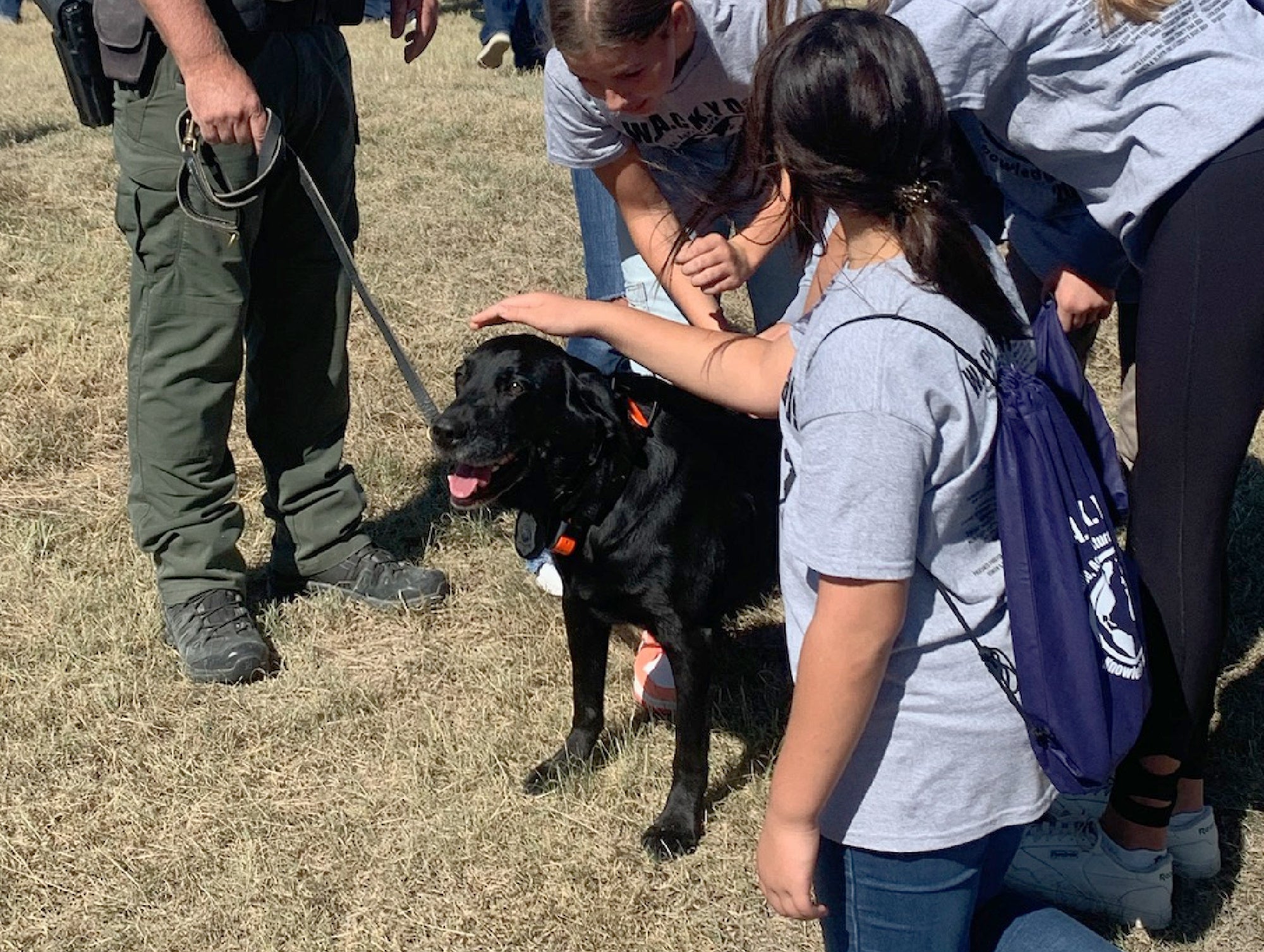
“This dog wasn’t certified yet. But luckily, my boss believed that he could be great. There was just something about him. So we got him fixed,” Brooke says. “They plated each leg, wired stuff together. For him to go through that, he just has this toughness to him. And after three or four days, he was grabbing pens out of the nurses’ pockets. They were like, ‘Can you please come get him? He’s tormenting everyone.’”
Training for the Job
Kreed’s formal training began when he turned a year old. He and Brooke had to complete 400 hours of instruction in nine weeks or less to be certified.
“The first step is man-tracking, where the dog is tracking a human being. That’s what the majority of that time is spent on,” Brooke says. “You run multiple tracks every day, tracking different people with different scents. Then we go into [the second category of] wildlife detection. Waterfowl, turkey, and deer are the three pretty common species, and then each officer will dive into something different in their area. I’m on the edge of north-central and northwest Kansas, and we have pheasants out here, so we train on pheasants.”
The third major element of training is evidence recovery, or what Brooke calls “area searches.”
“They’re looking for any items that humans have touched and handled. Your cell phone, your wallet, anything that’s been handled a little bit and has scent on it,” he says. “Then we train on burnt gunpowder residue, shells or casings, guns, things people leave behind. [Poachers] don’t always pick up their spent casings.”
At the beginning of a search, Brooke snaps a simple nylon collar around Kreed’s neck and pats his chest to get him fired up. The noise of the plastic buckle signals to Kreed that it’s time to work, and the verbal command “search” sends him on a frenzied hunt for any sort of scent. Whenever possible, Brooke works Kreed into the wind to help increase his odds of catching a whiff of something.
“As soon as you snap that collar on, he gets jacked up. He rears back and is so ready to go. Then he hears ‘search,’ and he knows ‘I am out there looking for anything I trained on,’” Brooke says.
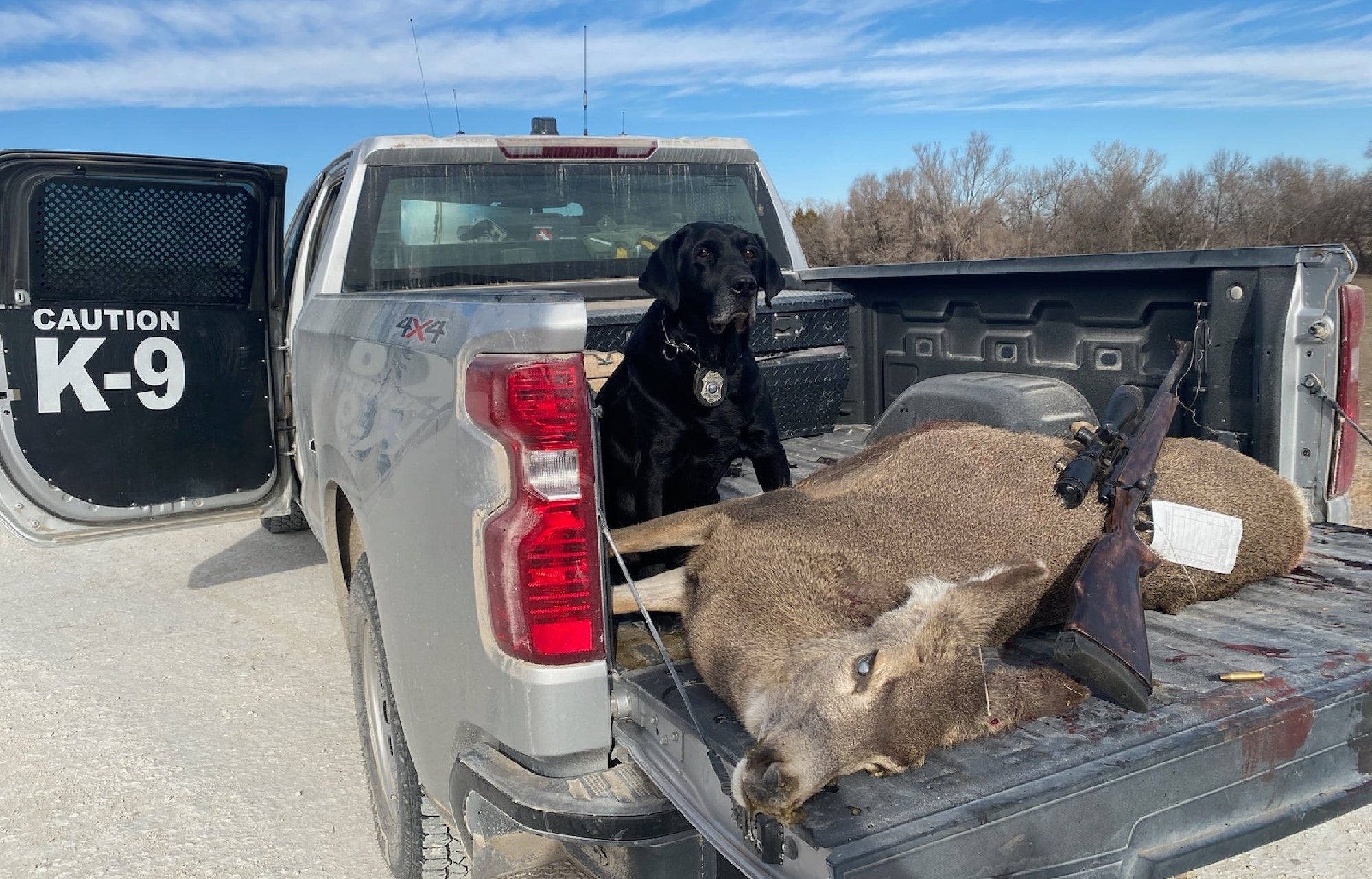
He keeps Kreed on a lead during detection and tracking work. If Kreed goes off-leash for an area search, he stays within Brooke’s immediate eyesight. K9s are often used to help find missing persons, children, and non-violent offenders.
Once Kreed finds something, Brooke rewards him then and there for his work. That means getting really excited, showering Kreed in praise, and throwing the rubber Kong while photographing evidence or taking notes.
“I’m gonna be 43 years old,” Brooke says, “and I act like a kid when I’m excited about him.”
Just Another Day
Back in the landowner’s field in Graham County, Brooke noticed the light had stopped moving. When he approached, he found Kreed sitting obediently next to the steaming body of a mule deer doe. More praise and more fetch ensued before Brooke carried on with the task at hand: taking notes of the scene. The landowner declined the meat, which eventually went to a nearby family in need. Yesterday, KDWPT announced that the suspect recently settled in court after pleading guilty for hunting without written permission from a landowner and shooting a deer without a license. The suspect paid a $1,500 fine and forfeited the rifle used in the incident.
Kreed struck again on Sept. 23 when he discovered a stash of dead ducks near a marsh in Jamestown, Kansas. A disorganized group of eight shooters left three birds behind after reportedly getting over-excited about the teal opener and failing to count properly. They even handed over a fourth duck during questioning. All eight were charged with shooting over their limit.
When Brooke and Kreed aren’t sniffing out wildlife criminals, they’re doing demonstrations for the public and teaching safety to kids. At a talk on boating safety, Kreed sat patiently on a jetski while sporting a life jacket and a boonie hat.
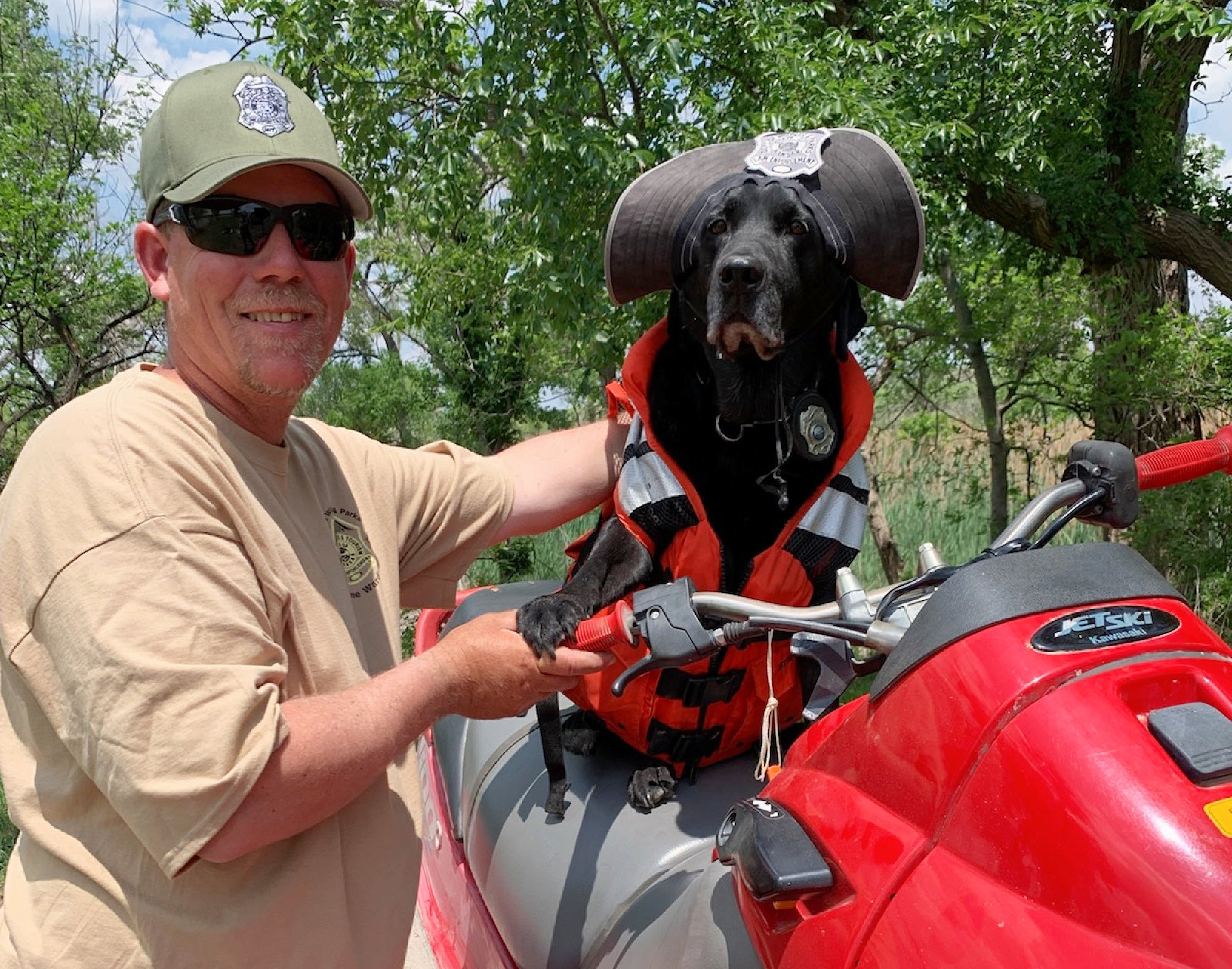
Even though Kreed works fewer than half of Brooke’s cases, the two are always on the clock together. When Brooke has a day off, Kreed has a day off—and that only happens twice a month. Kreed will likely work for another year or two before retiring to Brooke’s home full-time with his three other dogs: a chocolate Lab, a yellow Lab, and a Brittany spaniel. Then Brooke will start all over again and continue his job as a K9 handler with a third working dog. Whatever dog falls next in line behind Kreed and Brooke’s first dog, a female black Lab named Kooper, will have a big collar to fill.
Read Next: ‘Working Dogs for Conservation’ Is Training Rescues to Sniff Out Conservation Problems
“Kreed deserves a little bit of attention. There’s something about him. He’s so cool, and so tough,” Brooke says. “When you go to a [demonstration] and there will be 150 kids of all different ages, they’ll go through a few different stations or do different things, and then you ask them ‘What did you like the best?’ And their answer is always ‘the dog.’ He’s always the coolest part.”
The post Kreed the Conservation Dog Is a Poacher’s Worst Nightmare appeared first on Outdoor Life.
Articles may contain affiliate links which enable us to share in the revenue of any purchases made.
Source: https://www.outdoorlife.com/conservation/kansas-conservation-dog-kreed/




